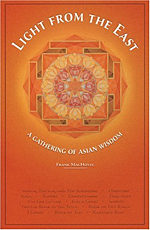"Orientation is a word with several meanings. It can refer to adapting to a new job or assignment or adjusting to a new idea. It is used when locating yourself on a map or in a building or other place. In ancient times 'the Orient' was a term for lands and people east of the Mediterranean. This book is 'oriented' to Eastern thought. By reading it you are being oriented to it.
"Multiple and hidden meanings are part of mystic thought and are crucial to Eastern religions and philosophies. When asked to define truth it is said that Buddha sat in silence and raised a beautiful flower high above his head. Another legend tells of Buddha answering the same question by describing a diamond as an example. Truth shines from every facet depending on the intensity and direction of light and the beholder's position relative to it. Absolute truth would be the diamond in its entirety with all its aspects. Each definition that Buddha gave was true and emphasized sensory experience, but he never presented anyone answer as being the complete truth. This book reflects a facet of truth as expressed in the Eastern approach, 'the light of Asia.'
ENLIGHTENMENT
"Light is a natural phenomenon. There is sunlight and moonlight. Making a fire and learning when and how to use it was a significant step forward in human history. Light has been a symbol of knowledge and wisdom as well, and is frequently referred to in Judeo-Christian scripture. The opening passage of Genesis describes the creation of the universe when God said: 'Let there be light.' In mystic thought light is used to signify spiritual enlightenment. Psalm 119 reads, 'Your word is a lamp to light my path, without which I would grope in the darkness:' In the New Testament, the Gospel of John quotes Jesus as saying, 'I am the light of the world" (8:12). In Romans 13:12 Paul says, 'Let us put aside the deeds of darkness and put on the armor of light.' In Matthew 5:14 Jesus tells his disciples, 'Let your light shine before men that they may see your good works and praise your father who is in heaven.'
"Other ancient civilizations also used light to symbolize truth and wisdom. The Egyptians believed the highest god came from or literally was the sun. The Persian Zend Avesta referred to forces of good and evil as those of light and darkness; Ahura Mazda led the forces of light and Ahriman led the dark forces. The Essenes, a Jewish communal group thought to have written the Dead Sea Scrolls, also referred to the forces of light and darkness. At his trial in ancient Athens, Socrates said that he was guided by his own 'inner lights.' Buddha described his goal in life as seeking enlightenment and his followers refer to him as 'the enlightened one.' Zen Buddhists seek satori, which translates as 'a flash of insight.'
"In every major world religion there have been groups of believers who sought more spiritual light: Gnostic Christians, Hassidic Jews, Sufi Muslims, Sikh and yogic Hindus, Zen Buddhists, and so on. Most see spiritual enlightenment as an individual rather than a group experience, though rituals are often used to stimulate spiritual experience and higher consciousness. For these believers, spiritual truth is more than rituals, teaching, and reading except to the extent that these activities help to realize deeper meaning. Hidden truths are sought beneath the surface of scripture and human interaction. Dylan Thomas described this kind of seeking with the line 'Light breaks where no sun shines.' Zen Buddhists refer to it as 'seeing with a third eye and hearing with a third ear.' Mystic light is caught, not taught or thought; it is earned rather than learned."
